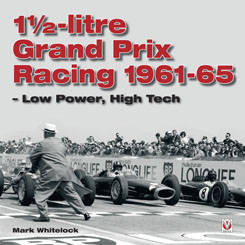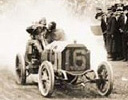Book Review
by Russell Jaslow
1½-litre Grand Prix Racing 1961-65 - Low Power, High Tech
by Mark Whitelock
Veloce Publishing
ISBN: 184584016X. List Price: $79.95.
  Seemingly, every series goes through a period of time when they "dumb" down the rules. In Indy car racing, it was called the Junk Formula during the 1930s. Formula 1 Grand Prix racing also went through this exercise when the FIA, shockingly, announced they were abandoning the 2½-liter engine formula in favor of a 1½-liter sized power plant, the same as in Formula 2, starting with the 1961 season.
Seemingly, every series goes through a period of time when they "dumb" down the rules. In Indy car racing, it was called the Junk Formula during the 1930s. Formula 1 Grand Prix racing also went through this exercise when the FIA, shockingly, announced they were abandoning the 2½-liter engine formula in favor of a 1½-liter sized power plant, the same as in Formula 2, starting with the 1961 season.
This five year period of Grand Prix racing has been overlooked. This makes sense when one considers the great eras in Grand Prix racing, it is easy to choose periods that capture the imagination and romanticism of racing -- the thundering silver monsters before WWII, the winged era of the late 60s, the ground effects in the 70s, the turbo era of the 80s, and the super high revving engines of the 90s.
This is a shame, because many important historic moments in Grand Prix racing came out of that period. For American fans, this formula should be one of their top choices since it led to the first Yank to win a World Driving Championship. While the British teams and manufacturers wasted away the years leading up to the rule change trying to get it rescinded, Ferrari spent the time developing a car just for it. This enabled the Maranello boys to dominate the first year with Phil Hill taking the title.
This time period saw the end of Stirling Moss' career while producing some of the greatest drivers to ever come out of the UK -- Graham Hill, Jim Clarke, John Surtees, and Jackie Stewart. For all those who complained at the time that technology was being handcuffed, some of the most important advances were developed. Tops on the list was the F1 monocoque chassis design introduced by Colin Chapman in the 1962 Lotus 25. Others included the Hewland gearbox, the first 12-cylinder F1 engines, advances in electronic fuel injection and four valves per cylinder, and large leaps forward in suspension technology. It also saw Porsche come and go in F1 and the debut of Honda.
Tires, too, changed the face of Grand Prix racing during that era. Though Dunlop was the only tire manufacturer for most of the time, they didn't take the easy route. They continuously developed their tread and more importantly aspect ratio, so that by the end of 1965, tires were well on their way to becoming low, wide slicks, enabling lap records to be lowered by considerable amounts despite the much smaller engines. Goodyear also entered F1 for the first time near the end of this formula, and won their first race.
Despite all of this, the 1½-liter formula had been ignored all this time. Until now. For the first time, a book is devoted exclusively to this time period thanks to Mark Whitelock. This rookie author has produced a winner. In a year by year account, Whitelock presents each year's championship in chronological order with each chapter concluding with a technical overview of the season. He seems to hit just the right note in presenting enough detail for historical accuracy while not overburdening the text with too much detail.
It is done in a scholarly style. This means it concentrates on just the facts, and does not bring out the characters of that era, which is something I would have liked. However, don't assume that means it is a dry read. Instead, and here I disagree with Raymond Baxter who wrote the forward, the prose moves the reader along quite nicely, and it easily has you riveted describing some of the races, especially the 1961 Dutch Grand Prix which had a 100% finish rate, the 1964 Belgium Grand Prix with perhaps the most bizarre ending in F1 history, and the 1964 season finale Mexican Grand Prix where no less than three drivers had a shot at the championship which was decided on the dramatic final lap.
Some of the photo captions are frustrating. For some reason, Whitelock never uses the numbers to identify the cars. Thus, there are times it was nearly impossible to figure out what car he is talking about, since not all of us are experts in identifying chassis, which he always lists. Plus, I was particularly annoyed when he made the geographical faux pas of describing Watkins Glen as New England countryside.
At first, I was surprised when I was halfway through with the book, and it appeared to be done. Then, I discovered that after presenting the information in a seasonal account, the author lays out the information by category, thus enhancing the scholarly value of the book. If someone just needs to look up a particular piece of information, they will easily be able to locate it without much page turning.
First comes a section on all the tracks used in that era (my favorite part). A chassis directory appears next, detailing every chassis that was built for those five years (a designer's favorite part). Finally, for the motorhead's favorite part, comes the engine directory and all the detailed specifications that go with it. Numerous cutout drawings in these later two chapters add greatly to the information. And of course, the photos throughout the book are priceless.
Like the book jacket says, "The 1½-litre GP era is often largely overlooked." Mark Whitelock has now made that statement obsolete. The English author does present this book from a British perspective, but that is not out of order. After all, with the exception of the first year, this era was dominated on the results sheet, in the cockpit, and on the designer's board by the Brits. Ironic, considering no one in Great Britain ever wanted the formula in the first place.
For any Grand Prix enthusiast, or racing fan in general, the 1½-litre Grand Prix Racing 1961-65 - Low Power, High Tech is a must to fill in that historic hole on your bookshelf.
Copyright © 2006 by . All Rights Reserved.
|



